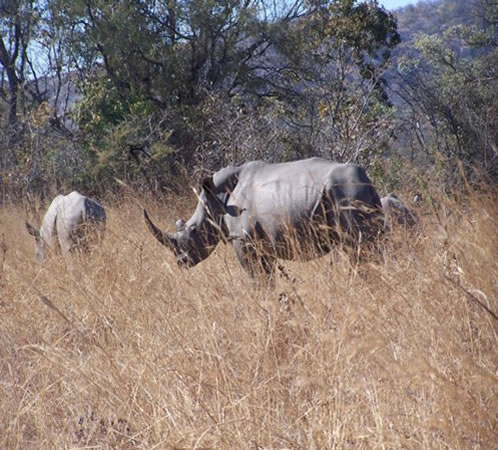
The national park is the oldest in Zimbabwe, established in 1926 as Rhodes Matopos National Park, a bequest from Cecil Rhodes. The original park borders extended well to the south and east of the current park. These areas were redesignated for settlement as part of a compromise between the colonial authorities and the local people, creating the Khumalo and Matobo Communal Lands. The park area then increased with the acquisition of World's View and Hazelside farms to the north. The current name Matobo reflects the correct vernacular pronunciation of the area.
Matobo National Park has a wide diversity of fauna: 175 bird, 88 mammal, 39 snake and 16 fish species.Game include white Rhinoceros, sable antelope, impala and leopard. The park contains the world's densest population of the latter, due to the abundance of hyrax, which make up 50% of their diet. The game park in the west has been restocked with white and black rhinos, the former from Kwa-Zulu Natal in the 1960s and the latter from the Zambezi Valley in the 1990s. It has been designated as an Intensive Protection Zone for the two species, as well as giraffe, zebra, wildebeest and ostrich. Matobo National Park contains the highest concentration of black eagles, and breeding pairs of these birds, worldwide. Mother and Child Kopje in the game park, Matobo National Park A limnological research centre has operated since 1950 at Maleme Dam and researched species such as the yellow-fish Barbus mattozi.
San (Bushmen) lived in the hills about 2,000 years ago, leaving a rich heritage in hundreds of rock paintings. There are over 3,000 registered rock art sites, with the main periods of painting being between 320 and 500 C.E.. In the many crevices and caves, clay ovens and other historic artefacts have been found, and various archaeological finds date back as far as the Pre-Middle Stone Age, around 300,000 B.P.The following major sites have been developed for tourist access: Bambata Cave is also a major archaeological site, located in the west of the national park, north of the game park on the Kezi-Bulawayo road. The frieze includes elephants, giraffes, warthogs, tsessebe and mongoose. Inanke Cave has the most extensive paintings, located in a remote cave accessible by a three-hour hike from Toghwana Dam. Along the route of the hike is an iron age furnace. Nswatugi Cave contains beautiful friezes of giraffes, elephants and kudu. Access is from Circular Drive, west of Maleme Dam Pomongwe Cave, near Maleme Dam, was damaged by a preservation attempt in 1965, where linseed oil was applied to the paintings. Archaeological digs within and downslop of the cave revealed 39,032 stone tools, several hearths, with the main fire-making areas were in the centre of the cave floor. Bone fragments showed that hyrax formed a major part of the meat component of the diet of early human inhabitants of the cave, which also included tortoise and larger game animals. The oldest material on the site is probably pre-Middle Stone Age.